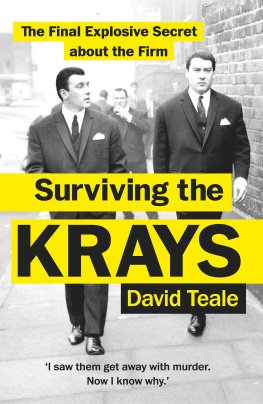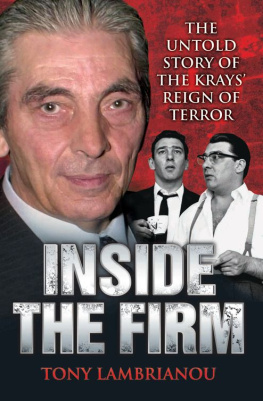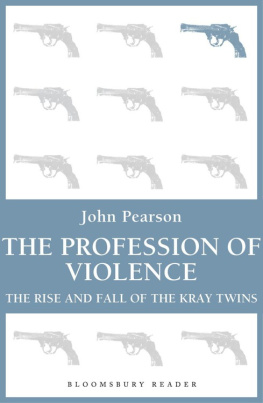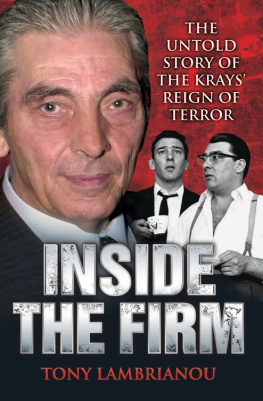REG AND RON KRAY
OUR STORY
Londons most notorious
gangsters, in their own words
with Fred Dinenage
PAN BOOKS
To our mother
Our Mum
Mum you are like a rose.
When God picked you, you were the best mum
he could have chose.
You kept us warm when it was cold
With your arms around us you did fold.
For us you sold your rings of gold.
When you died, I like a baby cried.
When I think of you it is with pride,
So go to sleep mum I know that you are tired.
Ron
INTRODUCTION
I sentence you to life imprisonment, which I would recommend should not be less than thirty years.
So said Mr Justice Melford Stevenson to the Kray twins, Reggie and Ronnie, at the Old Bailey, on 8 March 1969. They had been found guilty of the gangland killings of George Cornell and Jack The Hat McVitie. The twins were thirty-four. At the time of the publication of this, their own story, they are fifty-four. They still, therefore, officially have ten years left to serve.
Most of Reggie Krays twenty years in captivity have been spent as a Category A prisoner in the maximum-security Parkhurst prison near Newport on the Isle of Wight. At the time of writing he is at maximum-security Gartree prison near Market Harborough in Leicestershire. Despite repeated appeals he has been given no official indication that he will serve anything less than the thirty years to which he was sentenced.
His brother Ronnie began his sentence at Durham gaol, was then transferred to Parkhurst after a campaign led by the twins mother, but has spent the last sixteen years at Broadmoor maximum-security psychiatric hospital near Crowthorne in Berkshire. He believes that he will never be released.
Fred Dinenage
FOREWORD
As the old clich has it, there are three ways out of the gutter for kids from the ghetto: boxing, singing and crime. For Reg and Ron Kray, boxing was their first choice. Both boys were handy with their fists, both were promising fighters, and both trained at the Repton Boys Boxing Club Londons oldest boxing gym, established in 1884 and still standing today. It was at this gym that I interviewed one of the Krays most feared gangland rivals, Mad Frankie Fraser, for Skys documentary, The Krays. Fraser was full of praise for Reg and Ron and recalled watching as the twins fought each other in the backyard at their home when they were lads.
They were fearless little bastards, said Frankie, and they were knocking shit out of each other. Both of em could have been champions but they kept getting into bother with the law. In the end the pair of em were blacklisted and that was the end of their boxing.
Fraser revealed that the Krays had tried to persuade him to leave their rival Charlie Richardsons gang and join them. But I decided not to, said Frankie. I liked the twins but I thought Charlie had got more brains. I thought he was more of a businessman. Fraser, despite various altercations with the Krays over the years, ended up being close friends with the twins, especially Ron, with whom he spent several years at Broadmoor.
So, professional boxing was out for the twins, and they couldnt sing, but their fame as gangsters has kept them in the public eye in this country for as long as Sixties icons The Beatles and Elvis Presley. I am always amazed by, not only how well remembered the Krays are by people who were around in the sixties and seventies, but how widely their name is known among younger generations who seem to endlessly devour books, films and TV shows about the brothers. The documentary I made for Sky about the Krays has been repeated several times and, as I write, is still being shown. When first transmitted, it attracted the biggest audience Skys Crime Investigation channel had ever known. And the Krays fame is not confined to the UK. Their name is known on the Continent, in Australia and, thanks to the Kemp brothers 1990 film, in the US. Our Story, when first published, spent several weeks at the top of the Sunday Times bestseller list.
What is their long-lasting appeal? Why are they still so famous? Why do people, young and old, find their story so engaging years after they ruled the streets of the East End and years, even, since they both died? Maybe its nostalgia; a memory of a time when life seemed simpler, less complicated. But while some are quick to mythologize the brothers, others are less positive about Reg and Ron Kray. The family of Reggies beautiful wife Frances, who died aged twenty-four, are among them. Many of Frances family have their own beliefs about what happened to her. There are even unproven theories that she was murdered.
Many of the Krays own gang, known as the Firm, also have bad memories of the brothers particularly Ron. I spoke to one former member in the Carpenters Arms, the pub bought by the twins for their mother. Its in Cheshire Street, just a hundred yards from their old home on Vallance Road. Today its considered a trendy place; back then, its been claimed, the counters were made of coffin lids.
The former Firm member told me: I fell out with Ronnie but then I got a message to meet him in a flat. I thought we were going to talk things over, get things sorted. But when I got there he was with some other guys from the Firm. Ron started to slag me off. He was screaming and shouting. Saliva was coming out of his mouth. Then the guys held me down while Ron got a red-hot poker from the fire and held it against my face. I screamed and screamed. Ive still got the scar. But Ron just fucking laughed. He was a cruel bastard.
Working on this book with the Kray twins was never going to be easy. That was the warning I was given by several people, including the governor of Parkhurst Prison, and the Medical Director at Broadmoor Hospital for the Criminally Insane.
The project began in 1985 after Reg saw a programme I had hosted on Coast to Coast, the nightly news listing for the south of England. I remember the report vividly. It featured the father of a young girl whose life had been saved by a kidney transplant. To show his thanks he wanted to raise money to buy some specialized equipment for the hospital. A couple of days after the programme had aired I received a letter franked by HMP Parkhurst. It was from Reg Kray. The writing, difficult to decipher because of the scrawling hand that Reg shared with his brother, said, I watched the film on your programme. I would like to help. There are some talented artists here in Parkhurst. You could sell some of their paintings to make some money.
I confess I was a little startled to receive this letter. I was aware of the Krays, of course. I was a young man in the fifties and early sixties when they made headlines as they ruled the streets of London and were finally sent down by Leonard Nipper Read. Nipper Read was a Chief Superintendent on the Mets Murder Squad in the mid-sixties and dedicated his life to bringing down the Kray twins. Ironically, he shared their love of boxing and he was once even chairman of the British Boxing Board of Control. The name Kray was, at that time, still powerful enough to create a certain amount of apprehension. But, as a journalist, it was an invitation I couldnt refuse.
After a few weeks, thirteen paintings arrived at our studios in Southampton. Twelve of them were very good. The thirteenth was a childlike painting of two boxers in a ring, signed R. Kray. In terms of technique, it was atrocious, but it was the top seller at the auction and has since been sold on for even more money. We ran another item on Coast to Coast about the auction and, a few days later, I received another letter from Reg: Why dont you come and visit me at Parkhurst?
Next page












